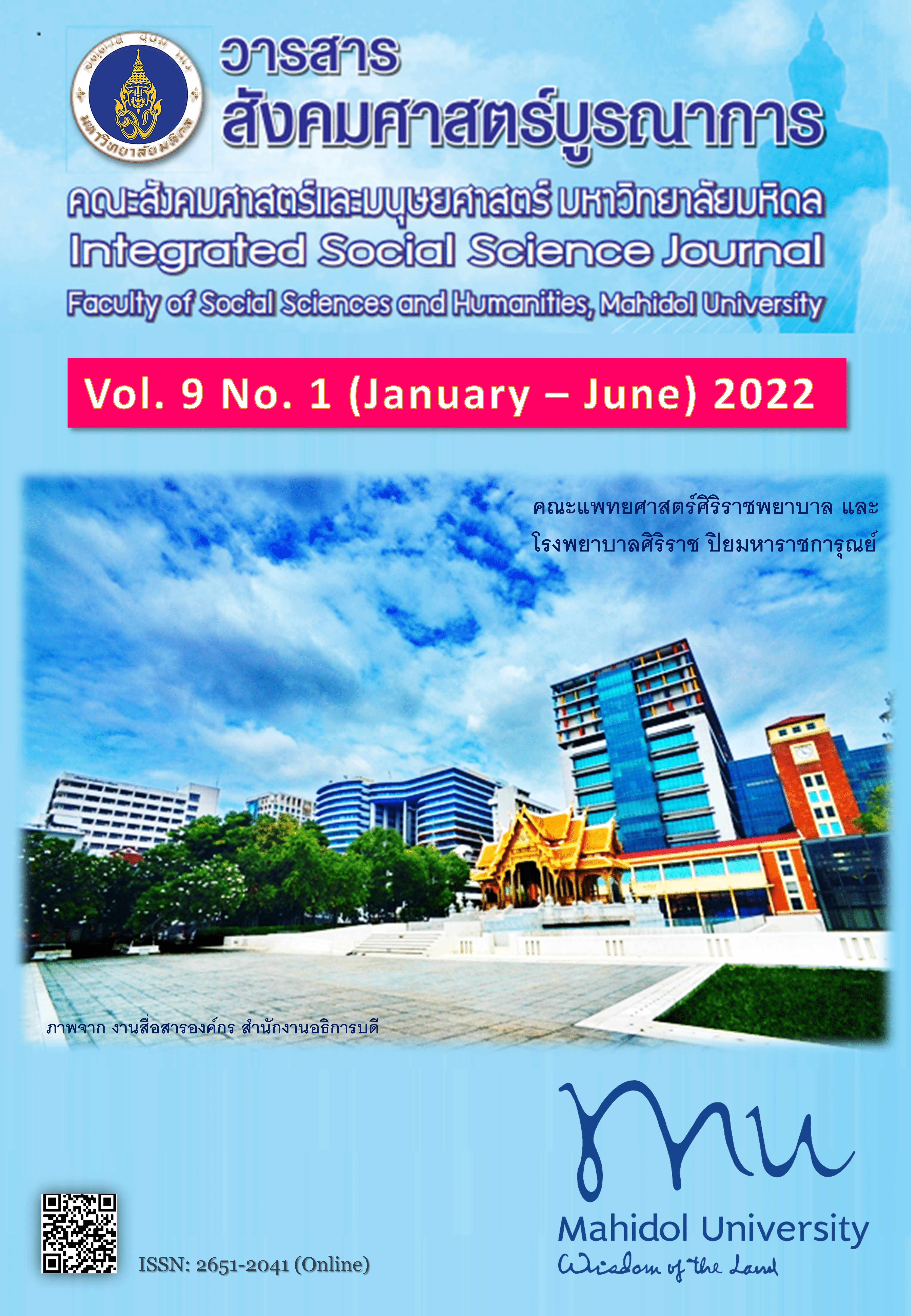โรคติดการพนัน: สภาวการณ์และแนวทางในการป้องกัน
Main Article Content
บทคัดย่อ
การวิจัยนี้มีวัตถุประสงค์เพื่อ (1) ศึกษาสภาวการณ์ของโรคติดการพนันของคนไทย (2) ศึกษาปัจจัยเสี่ยงต่อการเป็นโรคติดการพนัน (3) ศึกษาผลกระทบของโรคติดการพนันที่มีต่อสังคมไทย และ (4) แสวงหาแนวทางในการป้องกันและฟื้นฟูบำบัดโรคติดการพนันในสังคมไทย การวิจัยนี้เป็นการวิจัยเชิงคุณภาพ เก็บข้อมูลโดยการสัมภาษณ์ และการสนทนากลุ่มผู้เชี่ยวชาญด้านการพนัน ผลการศึกษาพบว่า สถานการณ์โรคติดการพนันในสังคมไทยนั้นมีแนวโน้มความรุนแรงเพิ่มขึ้น โรคติดการพนันเปรียบเสมือนการเสพติด คือ เกิดขึ้นจากการเล่นการพนันอย่างต่อเนื่องและไม่สามารถที่จะหยุดได้ โดยกลุ่มเสี่ยงต่อการเป็นโรคติดการพนัน ได้แก่ กลุ่มเด็กและเยาวชน โดยการเรียนรู้จากครอบครัว ความอยากรู้อยากลอง และกลุ่มเพื่อนจะมีอิทธิพลต่อการเสี่ยงติดการพนันได้เช่นกัน สำหรับกลุ่มผู้ใหญ่นั้น พบว่า เกิดจากการแสวงหารางวัลเพื่อเป็นรายได้ และบางกลุ่มเครียดจากการทำงาน ซึ่งกลุ่มที่มีความเสี่ยงในวัยผู้ใหญ่ ได้แก่กลุ่มวัยเริ่มต้นทำงาน เนื่องจากมีความต้องการทางด้านเศรษฐกิจที่สูง สำหรับปัจจัยหลักที่ทำให้เกิดโรคติดการพนันมี สองปัจจัยคือ ปัจจัยส่วนบุคคล เช่น การชอบความเสี่ยง ความท้าทาย และปัจจัยทางสังคม เช่น สภาพแวดล้อม ซึ่งปัจจัยเหล่านี้เป็นสิ่งกระตุ้นทำให้อยากเล่นการพนันจากเกิดเป็นการติดพนัน และบางกรณีเข้าข่ายโรคติดการพนัน สำหรับแนวทางในการป้องกันและฟื้นฟูบำบัด ผู้วิจัยเสนอว่า ควรมีการประสานความร่วมมือกันหลายฝ่ายทั้งทางด้านกฎหมาย สังคม และการให้ความรู้แก่ประชาชน เช่น การมีศูนย์ป้องกันการพนันในชุมชน การให้ความรู้เกี่ยวกับการพนัน นอกจากนี้ควรเป็นการประสานความร่วมมือทั้งในส่วนของภาครัฐ เอกชน และประชาชนในการเข้ามามีส่วนร่วมในการป้องกันการพนันเพื่อไม่ให้เกิดโรคติดการพนันในชุมชนนั้นเอง
Article Details

อนุญาตภายใต้เงื่อนไข Creative Commons Attribution-NonCommercial-NoDerivatives 4.0 International License.
- วารสารสังคมศาสตร์บูรณาการ มหาวิทยาลัยมหิดล อนุญาตให้สามารถนำไฟล์บทความไปใช้ประโยชน์และเผยแพร่ต่อได้ โดยอยู่ภายใต้เงื่อนไขสัญญาอนุญาต CC Attribution-NonCommercial-NoDerivatives 4.0 International (CC BY-NC-ND 4.0) โดยต้องแสดงที่มา/การอ้างอิงจากวารสาร – ไม่ใช้เพื่อการค้า – ห้ามแก้ไขดัดแปลงเนื้อหา
- ข้อความที่ปรากฏในบทความในวารสารฯ เป็นความคิดเห็นส่วนตัวของผู้เขียนแต่ละท่าน ไม่เกี่ยวข้องกับกองบรรณาธิการวารสารฯ (ซึ่งหมายรวมถึง บรรณาธิการ ผู้ทรงคุณวุฒิในกองบรรณาธิการ หรือ บรรณาธิการรับเชิญ) แต่อย่างใด ความรับผิดชอบองค์ประกอบทั้งหมดของบทความแต่ละเรื่องเป็นของผู้เขียนแต่ละท่าน หากมีความผิดพลาดใด ๆ ผู้เขียนแต่ละท่านจะรับผิดชอบบทความของตนเอง ตลอดจนความรับผิดชอบด้านเนื้อหาและการตรวจร่างบทความเป็นของผู้เขียน ไม่เกี่ยวข้องกับกองบรรณาธิการวารสารฯ
- กองบรรณาธิการขอสงวนสิทธิ์ในการตัดทอน/ปรับแก้ถ้อยคำบางประการเพื่อความเหมาะสม
เอกสารอ้างอิง
พีรศาสตร์ จินาปุก. (2552). กระบวนการติดการเล่นพนันฟุตบอลของประชาชนในเขตเมืองเชียงใหม่. มหาวิทยาลัยเชียงใหม่.
ไพบูลย์ วัฒนศิริธรรม. (2555). ร่วมสร้างประเทศไทยด้วยมือเรา. วี.พริ้นท์.
ผาสุก พงษ์ไพจิตร. (2543). อุตสาหกรรมการพนัน: ไทย อังกฤษ สหรัฐอเมริกา ออสเตรเลีย และมาเลเซีย. พริ้นติ้งเฮ้าส์.
สุธาสินี ทองลิ่ม. (2555). เวทีขับเคลื่อนนโยบายสาธารณะเพื่อป้องกันเด็กเยาวชนจากการพนัน. บริษัททีคิวพีจำกัด.
สมประวิณ มันประเสริฐ. (2554). การศึกษาสถานการณ์ พฤติกรรม และผลกระทบการพนันในประเทศไทย: การศึกษาเชิงปริมาณด้วยแบบจำลองทางเศรษฐศาสตร์. สำนักงานกองทุนสนับสนุนการสร้างเสริมสุขภาพ (สสส.).
สุพร อภินันทเวช. (2555). เยาวชนกับการพนัน ในมุมมองของจิตแพทย์เด็กและวัยรุ่น. บริษัท เอมี่ เอ็นเตอร์ไพรส์ จำกัด.
ศูนย์ศึกษาการพนัน (2555). เรียนรู้ เท่าทัน การพนัน ทันเกม. โรงพิมพ์เครือข่ายเดือนตุลา.
Hardoon, K. K., Gupta, R., & Derevensky, J. L. (2004). Psychosocial variables associated with adolescent gambling. Psychology of Addictive Behaviors, 18, 170-179.
Jazaeri, S. A., & Habil, M. H. (2012). Reviewing two types of addiction – Pathological gambling and substance use. Indian Journal of Psychological Medicine, 34(1), 5–11.
Ladouceur, R., Boisvert, J., & Dumont, J. (1994). Cognitive behavioral treatment for adolescent gamblers. Behavior Modification, 18, 230-242.
Welte, J. W., Barnes, G. M., Wieczorek, W. F., Tidwell, M. O., & Parker, J. C. (2004). Risk factors for pathological gambling. Addictive Behaviors, 29, 323-335.
Williams, R. J., West, B. L., & Simpson, R. I. (October 1, 2012). Prevention of problem gambling: A comprehensive review of the evidence and identified best practices. Report prepared for the Ontario Problem Gambling Research Centre and the Ontario Ministry of Health and Long-Term Care.


